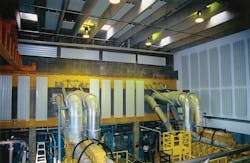Controlling Noise at Coney Island
Industrial plants are known for being loud, acoustically raucous environments. The combination of high ceilings, reflective surfaces and output from heavy machinery create an optimal environment for sound to project and resonate. When this occurs, productivity decreases and safety hazards increase, creating a unique challenge for facility managers. This is the problem that the Coney Island Wastewater Treatment Plant needed help solving after evaluating the acoustic levels in its facility.
The U.S. Occupational Safety and Health Administration ran tests throughout the treatment facility and established that noise levels in the pump room and blower room exceeded safe levels. Average background noise levels in the pump room were 92 dBA, and in the blower room were 87 dBA. At this level communication among plant workers becomes difficult, if not impossible. Part of the problem was the construction of the two large rooms. The walls and floors were concrete and the ceiling was metal deck, all of which are highly reflective surfaces. Both rooms included multiple pieces of noise-generating equipment. After considering these factors, the plant’s operators decided the best course of action was to treat the issue by installing sound absorbing panels.
The Coney Island Wastewater Treatment Plant invited Eckel Industries to assess the facility and implement an acoustical treatment. After an evaluation, Eckel suggested the installation of its sound-absorbing Eckoustic Functional Panels (EFPs) on specific wall and ceiling surfaces to achieve a reverberation goal of 85 dBA or less. When installed properly, EFPs help absorb sound and reduce reverberation, increasing the clarity and intelligibility of speech. The paneling is ideal for industrial applications due to its versatile and durable design, which allow the panels to be installed in new or existing facilities without interference with utilities such as sprinklers, lighting, ventilation etc.
Generator Room
In the generator room, which is 87 ft wide x 153 ft long x 41 ft high, there are four sets of 2,500 hp diesel engine generators that drive 600 hp motors, which operate the pumps. Prior to installation of the EFPs, sound level measurements were taken at eight locations within the room at various distances from the engine generators.
For the ceiling treatment, three-quarters of the panels were 30 in. x 10 ft EFPs; the remaining were 30 in. x 8 ft. On the walls, the panel sizes were 48 in. x 8 ft and 24 in. x 6 ft. All of these sizes are standard sizes.
With one engine set and three pumps running, the background noise was reduced from 92.5 dBA to 82.7 dBA after EFP treatment, a reduction of 9.85 dBA. With two sets of engine generators and four pumps running, average noise levels were reduced by 6.98 dBA, to bring the overall noise level below 85 dBA
Blower Room
This room measures 53 ft x 120 ft x 25 ft., and similar results were obtained. Here too, a mix of panel sizes was used—30 in. x 10 ft, 30 in. x 8 ft, 30 in. x 4 ft, and 42 in. x 5 ft—as the most efficient means of achieving the noise reduction goal. A total of 2,651 sq ft of panels was adequate for effective treatment. With two blowers running, the average levels noise reduction with EFPs installed was over 5 dBA, from 86.6 dBA to 81.3 dBA.
Unit Sound Absorbing Panels offer several advantages as a method of adding sound absorption to spaces with hard reflective surfaces. They require little or no maintenance and are effective in lowering background noise and reverberation in a wide variety of industrial and architectural applications.
Jeffrey Morse is vice president of the acoustic division for Eckel USA. Morse can be reached at 617.491.3221.
